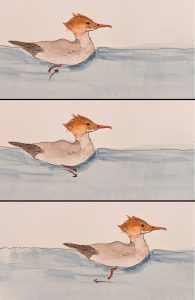Isadora Colpo


The common merganser belongs to the family anatidae, which includes ducks, geese, and swans, and within that, the subfamily anatinae (Delacour & Mayr, p 7). The anatinae subfamily molts twice a year and has sexual dimorphism in voice and plumage (Delacour & Mayr, p 7). Male mergansers have smooth black heads and white chests, while female mergansers have spiky reddish head feathers and softer grey chests. However, all mergansers have a thin, bright orange bill. Within its subfamily, mergansers belong to the tribe mergini, also called “sea ducks” or “diving ducks” (Delacour & Mayr, p 32). The name “diving ducks” sets them apart from more common “dabbling ducks”, such as mallards (Fig. 01). The name “sea ducks” is a bit of a misnomer — the common merganser can be found in coastal bays, but they can also be found in lakes or rivers in the middle of the country. Still, these birds have adapted to live in wide, open waters and dive for their food. They have short wings, which allow them to fly fast and low to the water, and wide feet, which make them “clumsy” (Delecour & Mayr, p. 32) on land but incredible swimmers (Fig. 02).
When spending their time in the ocean, mergansers stick to wintering in coastal bays, and often nest near the water (Audubon Society). They like clear, open water, avoiding “dense marshes and muddy waters” (Audubon Society). This preference is probably because mergansers hunt for their food mostly by sight (Audubon Society). The sight of feeding mergansers can attract gulls (Anderson, Reeder, & Timken p 475), and mergansers sometimes take advantage of “stunned or dead” (Timken & Anderson p 88) fish after they go through dams. Some people think of mergansers as competition for popular game fish, but this simply isn’t true (Timken & Anderson p 90). Mergansers living in fresh water tend to feed on “rough or forage fish” (Timken & Anderson p 90), and those closer to the coast feed on young Pacific salmon, but not to the point of threatening the species (Wood).
The common merganser is a predatory animal; it doesn’t seem to be under threat from other animals, including humans. Thus, most of its behavior is focused on breeding, hunting, and nesting. The merganser relies on sight for hunting; they often swim with their heads underwater to look for food. Sound doesn’t seem to be a factor in their hunting, and it doesn’t factor into communication that much, either. Like other sea ducks, mergansers are “very silent birds” (Delacour & Mayr p 33). They prefer flapping displays for mating (Delacour & Mayr 34) and even after catching fish (Anderson, Reeder, & Timken p 474). There is no need to look for food on land, or any use to it, because mergansers are clumsy on land due to their large feet and legs set near the back of their bodies. The only interest a merganser would have in land is its nesting possibilities. Mergansers nest in the cavities of dead trees, and so prefer wooded areas, but are careful to avoid swamps and marshes, where muddy water would restrict their sight.

References
Alexander, R.M. (2003). Principles of Animal Locomotion. Princeton University Press.
Anderson, B.W., Reeder, M.G., & Timken, R.L. (1974). Notes on the Feeding Behavior of the Common Merganser (Mergus Merganser). The Condor, 76(4), 472–476. https://www.jstor.org/stable/1365825.
Audubon Society. (n.d.). Common Merganser. https://www.audubon.org/field-guide/bird/common-merganser.
Delacour, J. & Mayr, E. (1945). The Family Anatidae. The Wilson Bulletin, 57(1), pp. 3-55. https://www.jstor.org/stable/4157393.
Timken, R.L. & Anderson, B.W. (1969). Food Habits of Common Mergansers in the Northcentral United States. The Journal of Wildlife Management, 33(1), pp. 87-91. https://www.jstor.org/stable/3799653.
Wood, C.C. (2011). Predation of Juvenile Pacific Salmon by the Common Merganser (Mergus merganser) on Eastern Vancouver Island. I: Predation during the Seaward Migration [Abstract]. https://www.nrcresearchpress.com/doi/abs/10.1139/f87-112.
